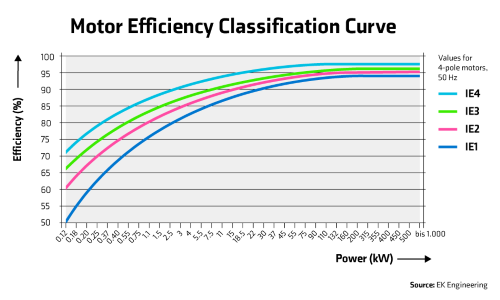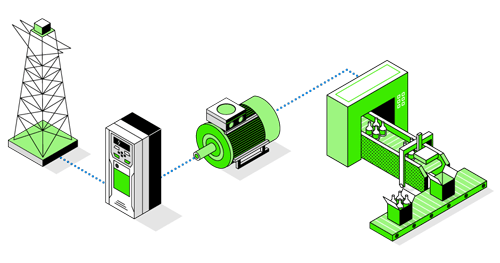As industries worldwide grapple with the need to reduce energy consumption and carbon footprints, the EU has been introducing a comprehensive framework aimed at enhancing the efficiency of electric motors used in industrial processes. A graduated process has been raising the minimum efficiency standards of new motors, broadening the scope of machines that are covered and widening the applications included.
Jeremy Wilkinson, Global Product Manager at Control Techniques, looks at how the latest EU directive will affect businesses and how a proactive approach can achieve greater energy savings.
The new EU Regulation 2019/1781 of directive 2009/125/EC (Energy related products) came into force on 1st July 2023, aimed at reducing energy consumption across all member states. The EU Commission estimates that large electric motors numbering around 80 million consume approximately 65-70% of the energy used in industrial applications. Beginning in 2009, the Commission set key measures to cut energy usage by issuing legislation covering the eco-design requirements of energy related products, namely electric motors and variable speed drives (VSDs).
Grasping the Latest Legislation
Earlier drafts required the majority of new 3-phase motors between 0.75 kW and 375 kW to be designed to IE3 (Premium Efficiency) or IE2 (High Efficiency) levels and installed with a VSD. Back in July 2021, the IE3 compliance band was expanded up to 1000 kW and the scope was widened to include motors fitted with brakes, most ATEX motors as well as motors for fan and blower applications using a totally enclosed air over (TEAO) design. At the same time, VSDs were required to meet the same rules as direct-on-line (DOL) motors.

The drive for greater energy efficiency has also encouraged the use of VSDs, which can be used in conjunction with the electric motor to improve control and efficiency. Previously, the minimum requirement for new equipment was an IE3 motor or an IE2 motor plus a VSD to deliver an efficiency that is equivalent to or better than IE3 efficiency rating.
Finding the Best Solution
This approach focusses on improving the efficiency of a specific product and reducing the losses associated with it alone. Specifiers and end users need to decide which option as a combination will provide the most efficient solution for their application; an IE3 motor has a clearly specified efficiency rating at its rated speed and at 50%, 75% and 100% load.
An application that requires variable speed adjustments and different loadings cannot be evaluated at present with the available product performance data. A specifier or an end user is currently unable to compare the different competitive components of the drive system and finally choose the most efficient motor and inverter components.
A similar situation arises when the motor is integrated into a product, such as a fan or a pump, where the motor's performance cannot be measured independently from the product. In order to address these situations and to improve the potential energy savings in these areas, a new standard, EN50598, has been being developed, which benchmarks the efficiency ratings of power drive systems (PDS).
Viewing the Complete System

EN50598-2 widens the focus from a single component to the efficiency of the complete power drive system (PDS). The new efficiency classes (IES) provide a structure that allows the losses for a complete drive system to be compared. The median range is IES1 and systems that fall below the minimum value of IES1 are classed as IES0. More efficient systems, with values 20% above IES1, are identified as IES2.
EN50598-3 provides a quantitative eco-design approach through life cycle assessment, including product category rules and the content of environmental declarations.
These new standards will also help end users to gauge payback periods more accurately. Previously, the overall efficiency of speed-controlled motors was estimated using rough energy consumption figures. Now, with verified efficiency curves, the payback period for a motor/drive combination can be calculated more realistically.
The Role of Drive Manufacturers
For manufacturers of VSDs there is a requirement to provide efficiency data according to the part load measurement points as defined for the CDM system, while those producing motors do not have to provide the efficiency data at the specified part load.
The Ecodesign Directive, 2009/125/EC, is also known as the Energy Related Products (ErP) Directive and relates to all products with a certain energy savings potential, which certainly includes VSDs. In many cases, the best solution for a controlled drivetrain system comes from a combination of drives and motors from different manufacturers. Aligning the known losses of these two components at the rated operating point enables them to be added together to achieve the necessary level of efficiency for the entire system and therefore the IES class. In the same way, losses at various partial load points can be calculated for specific application requirements.
Maximising the Benefits
Applying this to real-world examples shows that the greatest savings can be achieved by adding variable speed controls to applications with a variable torque, such as pumps and fans. The ability to fine-tune power delivery according to the requirements of the application ensure that process and energy efficiencies are both optimized.
However, energy efficiencies could be reduced if the variable speed drive is not setup and commissioned properly with the correct motor nameplate data. VSDs offer many benefits for operators aiming to improve their process efficiency and sustainability, provided they are correctly installed.
As a global specialist designer and manufacturer of drives, Control Techniques strives to deliver next-generation solutions, tailored to each application and meeting all local standards and directives. In a time when minimising energy consumption is crucial to the world’s sustainability goals, all drive manufacturers must play their role in helping end users to achieve optimum performance with reduced operating costs.
Browse all Technical blog posts
